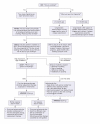Treatment of tobacco dependence: integrating recent progress into practice
- PMID: 18025429
- PMCID: PMC2072983
- DOI: 10.1503/cmaj.070627
Treatment of tobacco dependence: integrating recent progress into practice
Erratum in
- CMAJ. 2008 Mar 11;178(6):732
Abstract
Tobacco use is one of the leading preventable causes of death in developed countries. Adoption of approaches that have demonstrated efficacy to improve the treatment of tobacco dependence are critical to reduce the health consequences of tobacco use. We summarize the latest epidemiologic data on tobacco use, the mechanisms that underlie tobacco dependence, and advances in pharmacotherapy and nonpharmacologic interventions available for the treatment of tobacco dependence. Specifically, we discuss the use of nicotine replacement therapy, bupropion and varenicline in primary care settings.
Figures


References
-
- Tobacco Advisory Group of the Royal College of Physicians. Nicotine addiction in Britain: a report of the Tobacco Advisory Group of the Royal College of Physicians. London (UK): Royal College of Physicians of London; 2000.
-
- Department of Health and Human Services. The health benefits of smoking cessation: a report of the Surgeon General. Washington (DC): US Public Health Service, Office on Smoking and Health; 1990. - PubMed
-
- Canadian Tobacco Use Monitoring Survey (CTUMS) 2006. Ottawa: Health Canada; 2007. Available: www.hc-sc.gc.ca/hl-vs/tobac-tabac/research-recherche/stat/ctums-esutc/20... (accessed 2007 Oct 9).
-
- Shafey O, Dolwick S, Guindon GE, editors. Tobacco control country profiles 2003. Atlanta: American Cancer Society; 2003. Available: www.who.int/tobacco/global_data/country_profiles/en/ (accessed 2007 Oct 23).
-
- Department of Health and Human Services (DHHS). The health consequences of smoking. Nicotine addiction. Washington (DC): US Center for Health Promotion and Education, Office on Smoking and Health; 1988. DHHS Publ no (CDC) 88-8406.
Publication types
MeSH terms
Substances
LinkOut - more resources
Full Text Sources
Medical
